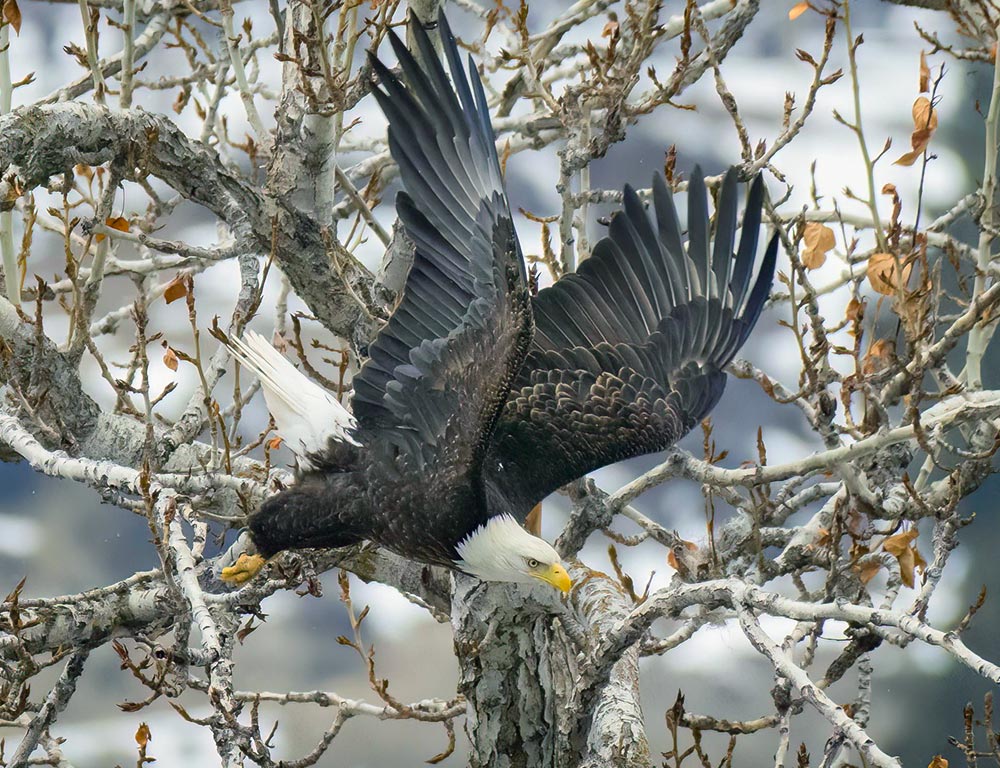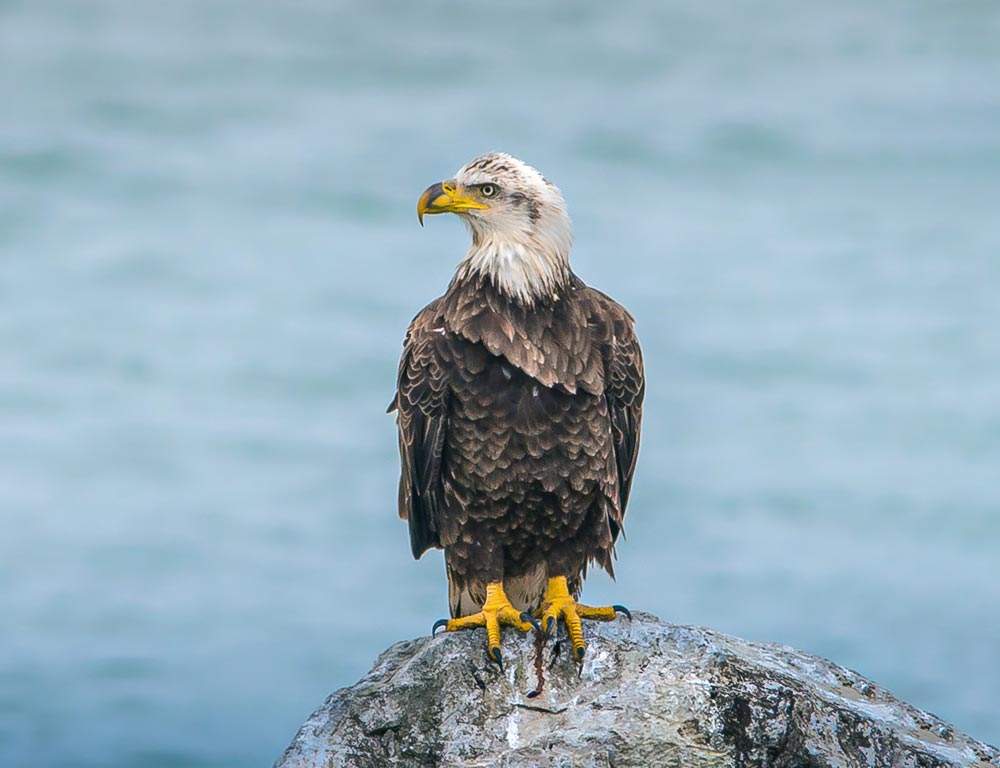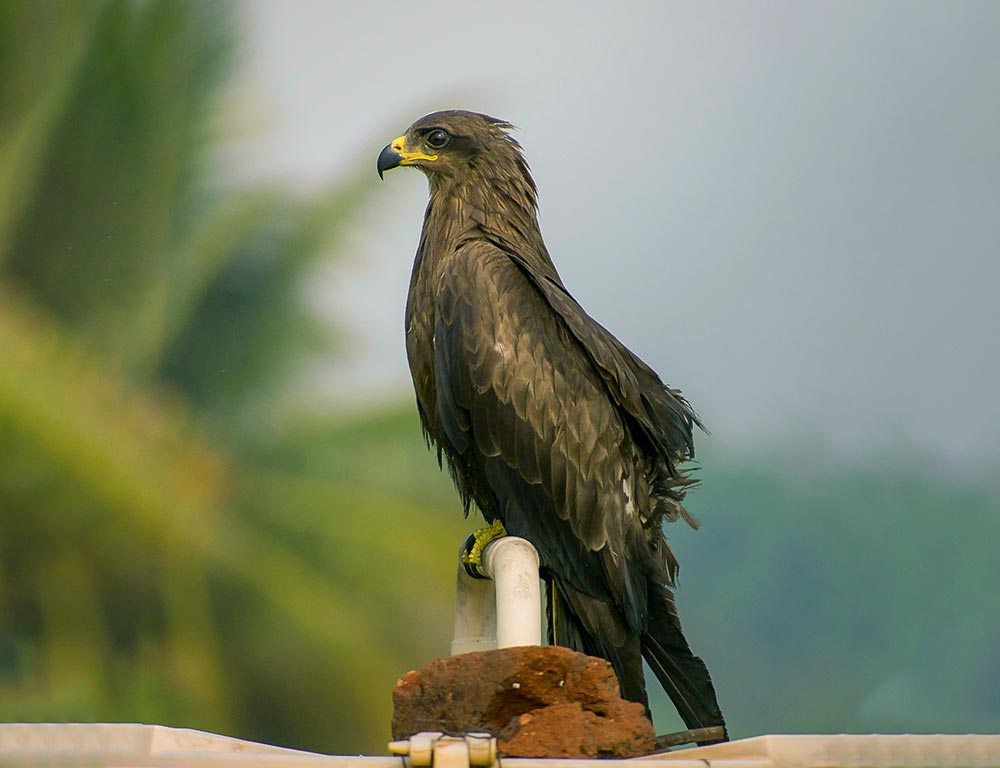Eagles do reside in Ohio, and their presence adds a captivating dimension to the state’s diverse ecosystems. Ohio is home to two prominent eagle species, the Bald Eagle and the Golden Eagle, each contributing to the rich tapestry of wildlife.
These majestic birds of prey, with their impressive wingspans and regal appearances, hold symbolic significance and embody the resilience of nature.
From Lake Erie’s shores to Hocking Hills’s woodlands, eagles can be spotted in various habitats.
In this exploration, we delve into the characteristics, habitats, and conservation efforts surrounding these magnificent eagles, unraveling the story of their coexistence with the Buckeye State’s natural landscapes.
Characteristics of Eagles in Ohio

Eagles in Ohio, specifically referring to the Bald Eagle (Haliaeetus leucocephalus), are remarkable birds known for their majestic appearance, impressive size, and significant role as a symbol of strength and freedom.
Here are some characteristics of Eagles in Ohio:
Physical Appearance
Bald Eagles are one of the largest birds of prey in North America. They have a wingspan reaching up to 7 feet, and adult females are generally larger than males.
Adult Bald Eagles are easily recognized by their distinctive white head and tail. Their body is mostly dark brown, with a hooked yellow beak and powerful talons.
Habitat
Bald Eagles in Ohio can be found near large open water bodies, such as lakes, reservoirs, and rivers. They prefer areas with abundant fish as it constitutes a significant portion of their diet.
Behavior
Eagles are known for their impressive soaring and gliding abilities. They have powerful wings that enable them to cover long distances during migration or while searching for food.
Ohio bald Eagles typically build large nests high in trees near their preferred water sources. These nests, known as eyries, are often reused and can become massive over the years.
Diet
The primary diet of Bald Eagles consists of fish, especially if they are found near water bodies. They are opportunistic predators and may also feed on waterfowl, small mammals, and carrion.
Eagles are known for their hunting prowess. They use their keen eyesight to spot prey from a great distance and then swoop down to catch it with their powerful talons.
Breeding and Reproduction
Bald Eagles mate for life, and their courtship rituals often involve impressive aerial displays, such as locking talons in mid-air and descending together.
The nesting season typically begins in late fall or early winter. They construct large nests using sticks and other materials, often in the same location year after year.
A typical clutch consists of one to three eggs, and both parents take turns incubating them. The eggs hatch after about 35 days.
Conservation Status
The Bald Eagle population in Ohio has seen a remarkable recovery after facing severe declines due to habitat destruction, pollution, and the use of pesticides like DDT.
Conservation efforts have contributed to their resurgence, including habitat protection and reintroduction programs.
Cultural Significance
Bald Eagles hold great cultural and symbolic importance in the United States and Ohio, representing freedom and strength.
Their image is often associated with patriotism and is prominently featured on the Great Seal of the United States.
In Ohio, the presence of Bald Eagles is a testament to successful conservation initiatives and the resilience of these magnificent birds in adapting to changing environmental conditions.
Observing eagles in their natural habitat is a thrilling experience and a reminder of the importance of preserving their habitats for future generations.
2 Types of Eagles in Ohio
In Ohio, the skies are graced by two remarkable eagle species, each with its distinct characteristics and significance.
The Bald Eagle, a symbol of national pride and freedom, and the Golden Eagle, a majestic hunter with regal plumage, share the Ohioan skies.
As nature’s ambassadors, these eagles captivate observers with their impressive wingspans and hunting prowess.
Here are the unique features and lifestyles of these magnificent birds, understanding their roles in Ohio’s ecosystems and the efforts made to ensure their continued presence in the state:
1. Bald Eagle

- Scientific Name: Haliaeetus leucocephalus
- Category: Sea and Fish Eagles
- Population: The Bald Eagle population has rebounded and is no longer considered endangered. Ohio has a notable population thanks to conservation efforts.
- Life Span: Bald Eagles can live up to 20-30 years in the wild.
- Size: Adults have a length of 28-40 inches.
- Weight: Adult Bald Eagles typically weigh between 8 and 14 pounds.
- Food: Primarily fish, but they are opportunistic and also consume waterfowl and carrion.
- Wingspan: A wingspan of 6 to 7 feet.
- Status: The Bald Eagle’s status has improved from endangered to least concern, a testament to successful conservation measures.
The Bald Eagle, the national bird of the United States, is an iconic species with a striking appearance. Its white head and tail contrasting against a dark brown body symbolize strength and freedom.
Found near water bodies in Ohio, these eagles build large nests in trees, showcasing impressive courtship rituals. They are skilled hunters, employing their powerful talons to catch fish and other prey.
Conservation efforts have played a pivotal role in their recovery, and their resurgence in Ohio is a testament to successful environmental stewardship.
2. Golden Eagle

- Scientific Name: Aquila chrysaetos
- Category: True Eagles
- Population: Golden Eagles are found in various regions, and their population in Ohio is relatively stable.
- Life Span: Golden Eagles can live up to 20-30 years in the wild.
- Size: Adults have a length of 26-40 inches.
- Weight: Adult Golden Eagles typically weigh between 6 to 15 pounds.
- Food: Mainly small to medium-sized mammals, birds, and occasionally carrion.
- Wingspan: A wingspan of 6 to 7.5 feet.
Status: Golden Eagles are generally considered a species of least concern.
The Golden Eagle, a majestic bird of prey, is a powerful and agile hunter found in Ohio. Its dark brown plumage and golden neck feathers contribute to its regal appearance.
Golden Eagles prefer open landscapes and mountainous terrain for nesting. They build large nests on cliffs and ledges.
Known for their exceptional vision, they spot prey from great heights and swoop down with incredible speed to catch it. Golden Eagles are adaptable, inhabiting a range of ecosystems.
Their presence in Ohio adds to the diverse avian population and reflects their ability to thrive in various environments.
Where to See Eagles in Ohio?
In Ohio, there are several locations where you can have a good chance of spotting eagles, particularly the Bald Eagle and occasionally the Golden Eagle. Here are some popular locations for eagle-watching in Ohio:
- Hocking Hills State Park: The diverse habitats, including lakes and forests, make it a potential spot for eagle sightings.
- Shawnee State Park: Nestled along the Ohio River, this park provides an excellent setting for spotting eagles. Keep an eye on the riverbanks and treetops.
- Magee Marsh Wildlife Area: While known for its significance during bird migration, Magee Marsh also attracts eagles. The marsh and nearby Lake Erie can be fruitful for eagle-watching.
- The Wilds: This wildlife conservation center offers guided tours where you might catch a glimpse of eagles along with other fascinating wildlife.
- Killbuck Marsh Wildlife Area: Situated in northeast Ohio, this large marshland is a haven for birdwatchers, and eagles are often spotted in the area.
- Hoover Reservoir: Near Columbus, Hoover Reservoir is known for its winter eagle watches. The reservoir provides an ample food source for eagles.
- Maumee Bay State Park: Located along Lake Erie, this park is known for its winter eagle-watching programs, offering guided tours to observe these majestic birds.
- Mohican State Park: The woodlands and waterways in Mohican State Park create an inviting environment for eagles. Keep an eye on the sky and the riverbanks.
- Scioto Audubon Metro Park: Situated in the heart of Columbus, this park features open spaces and water bodies, making it a potential spot for urban eagle-watching.
- Cuyahoga Valley National Park: The varied landscapes of this national park, including the Cuyahoga River, offer opportunities to spot eagles. Check out the overlooks for potential sightings.
Remember, the best times for eagle watching are often during winter, as eagles migrate to Ohio for open water and food sources.
Additionally, participating in organized eagle-watching events and guided tours can enhance your chances of a successful eagle sighting while providing valuable information about these magnificent birds.
How to Preserve Eagles in Ohio?

Preserving eagles in Ohio is crucial for maintaining biodiversity and ecological balance and ensuring the continued presence of these majestic birds. Several key measures can contribute to the conservation of eagles in the state:
Habitat Protection
Establish and enforce strict regulations to protect the natural habitats of eagles. It is essential to preserve nesting sites, particularly near water bodies where eagles find their primary food source.
Implement buffer zones around nests to minimize disturbances during the breeding season.
Environmental Education Programs
Develop and promote educational programs to raise awareness about the importance of eagles in Ohio’s ecosystems.
Engage communities, schools, and nature enthusiasts to foster a sense of responsibility and appreciation for these iconic birds.
Monitoring and Research
Conduct regular monitoring and research programs to track eagle populations, nesting success, and potential threats. This data is crucial for informed conservation strategies and adaptive management practices.
Mitigation of Human Disturbance
Implement measures to mitigate human disturbances, especially during the breeding season. Establishing viewing areas with regulated access and promoting responsible eagle-watching practices can reduce stress on nesting pairs.
Regulation of Pesticide Use
Enforce regulations on using pesticides and other harmful chemicals that can negatively impact eagle populations. These chemicals can accumulate in the food chain, threatening eagles and their reproductive success.
Collaboration with Landowners
Work collaboratively with private landowners to promote eagle-friendly land management practices. Encourage sustainable land use that supports prey populations and provides suitable nesting sites.
Rehabilitation and Rescue Programs
Establish and support rehabilitation and rescue programs for injured or orphaned eagles.
Swift response to incidents involving eagles ensures their timely medical attention and rehabilitation, increasing the chances of their return to the wild.
Preserving eagles in Ohio requires a multifaceted approach that combines legal protection, community engagement, scientific research, and habitat conservation.
By addressing natural and anthropogenic threats, Ohio can continue to be a stronghold for these iconic birds, contributing to the broader conservation efforts for raptors and their ecosystems.
Public involvement and a commitment to sustainable practices are integral to the success of these conservation initiatives, fostering a harmonious coexistence between eagles and the communities that share their habitats.
Wrapping Up
In safeguarding the eagles of Ohio, a harmonious blend of protective policies, community engagement, and ecological stewardship emerges as the key to a sustainable future.
Preserving their habitats, regulating human interactions, and fostering awareness are pillars in securing the skies for these iconic birds.
As Ohioans unite in their commitment to conservation, eagles’ soaring presence becomes a symbol of national pride and a testament to the collective responsibility we bear for our shared natural heritage.